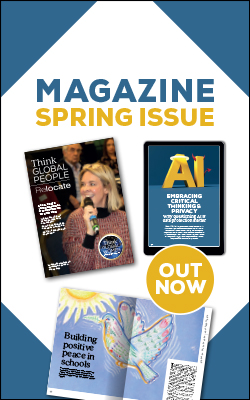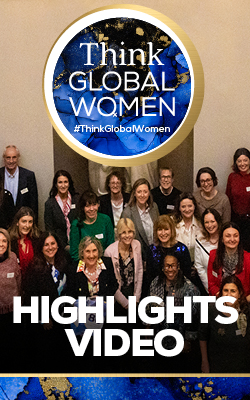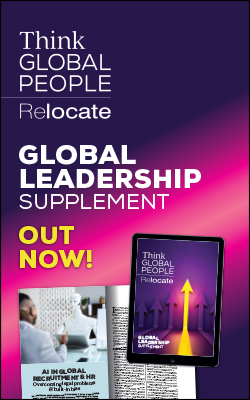Investing in the right technology: the global team perspective
Technology is powerful, but it doesn't automatically deliver the right answers. While upskilling your workforce and investing in new technology makes sound business sense, it is also important to understand where vulnerabilities lay, says Marianne Curphey.

This article is taken from the Autumn 2024 issue of
Think Global People magazine
Click on the cover to access the digital edition.There’s no doubt technology has supercharged the ability for organisations with global teams and disparate workforces to communicate, liaise and stay connected across different geographies and time zones. It enables virtual meetings, enhances flexibility and provides access to top talent without country or jurisdiction boundaries. Nevertheless, there are also dangers in this digitally reliant world. Data breaches, cyber-attacks and privacy issues are real problems for organisations and the cost of protecting systems is high. As the CrowdStrike global outage showed, digitalisation can empower people and organisations, but it can cripple us when things go wrong.While upskilling your workforce and investing in cloud and AI technology are important to future-proof the success of global organisations, global teams need to understand where the vulnerabilities are, make contingency plans and train staff to ensure the benefits of technology outweigh the risks, says Adam Pilton, senior cyber security consultant at CyberSmart and a former detective sergeant investigating cybercrime.“Every company should implement cyber security training and there should be a baseline level of cyber security training which all employees take – and it should be mandatory,” he says.
How to adapt technology for client needs
First the positives: technology can enable global organisations to be more inclusive and diverse.“As younger generations who have grown up immersed in technology enter the workforce, the audiences of global organisations are more diverse than ever in their preferred methods of communication and interaction,” says Catrina Kemp, marketing executive at Icon, an award-winning comprehensive relocation service.“Younger audiences are likely to prefer instant communication via mobile apps and AI tools, while older audiences may prefer telephone or email as more familiar methods.”In terms of clients, she says it is important for individual clients to be able to choose to engage in a way that is comfortable and familiar to them, whatever method that involves. “This is especially true in relocation, an already potentially stressful time in an individual’s life,” she says. “Offering technology could make their journey that bit more comfortable for them.”Being able to adapt and future-proof your business in this way enables greater diversity within an organisation. “Having the opportunity to draw upon a wide range of experiences, attitudes and skills from within your workforce is vital to ensuring you are continuing to evolve with your audience,” she explains.Read related articles
- Tech-focused, sustainable and personalised – here are the emerging trends in serviced apartment
- People first: tech adoption in the global context
- Talent for growth: innovation, skills and AI
- Harnessing AI for best-in-class performance management
- AI: technological transformation, upskilling and organisational design
Upskilling staff for maximum impact
Upskilling your workforce and investing in cloud and AI technologies are essential for future-proofing global organisations, says Jess Dunderdale, senior director of client partnerships at AltoVita, a corporate accommodation platform designed to help global mobility and travel managers source and book vetted extended accommodation.“At AltoVita, we have witnessed how these strategic investments drive innovation, enhance agility and position us as market leaders in technology within the corporate accommodation industry,” she says.“Our AI-driven GeoDiscovery Hub represents the pinnacle of innovation, optimising global mobility with unparalleled precision. By integrating cutting-edge image processing and object detection technologies, we not only enhance the accuracy of location insights, but also redefine how global teams interact with corporate accommodation.”Using AI in this innovative way, AltoVita can help organisations that are aiming to leverage global talent successfully. “With AltoVita, companies are not just investing in technology; they are investing in a future where global reach and local expertise blend seamlessly to drive success,” she says.While AI can be a powerful tool, it is still important to apply the human touch to make the most of its benefits. “At Work From Anywhere, we've seen first-hand how integrating cloud and AI technologies can revolutionise the way we work, but only when applied thoughtfully to the right use cases,” says John Lee, co-founder of Work From Anywhere.“For tasks with a wide margin of error, like drafting a blog post, generative AI tools can be incredibly effective. For example, if you request AI to generate ten images and just one meets your needs, that's still a win. However, when it comes to areas requiring precision – like delivering tax or legal advice – an error rate above 0.1% could have serious consequences.”This highlights the importance of applying common sense in any technology implementation, he says. Blending thoughtful experimentation with practical judgment enables you to foster a culture that values curiosity and adaptability, maximising the benefits of these innovations.“My advice to other leaders is to prioritise learning and development as much as you do technology investments,” he says. “Cultivate a growth mindset throughout your organisation, and recognise that upskilling should be an ongoing journey, not a one-time initiative. This balanced approach to people and technology is crucial for future-proofing your business in an increasingly digital world.”Understanding the vulnerabilities of technology
As organisations become more dependent on technology, systemic risks also rise. Integrating AI and cybersecurity will undoubtedly help mitigate the increasingly volatile threat landscape, but it does require investment.“Cybercrime is expected to surge by 15% this year and ransomware is on the up,” says Camellia Chan, CEO and co-founder of Flexxon, a Singapore-based cybersecurity company.“The NCSC’s annual report highlights it as one of the biggest threats to domestic organisations today,” she says. “But the truth is, the industry has been talking about the rise of ransomware ever since I started working in the space. That’s because as technology gets more sophisticated, so do cybercriminals. It’s a never-ending game of cat and mouse. We desperately need innovation to combat the threat. That starts with AI.”However, she argues that AI is a “double-edged sword” for organisations. As well as supercharging the ability to prevent, detect and respond to cyber threats, AI lowers the barriers of entry for cybercriminals. Coding is easier and so is creating a phishing email that looks legitimate, for example.“That’s why AI-based innovation and tools that secure the entire life cycle of an attack – from incident detection to response and recovery – are needed,” she says. “Traditional software defences that are reactive and human-dependent, such as antivirus, are not enough anymore. They do an excellent job at detecting known threats, but zero-day attacks elude them completely.”‘Zero day’ is the industry term for a cyber-attack that exploits an unknown security flaw in computer software, hardware or firmware. The term refers to the fact that the vendor of the software or device has no time to fix the flaw before malicious actors can use it.“When used at the physical level, AI-enabled solutions can run autonomously and proactively without the need for human intervention due to the enclave environment and well-defined protocols,” she says. “AI’s intuitive and self-learning nature is a game changer in delivering zero-day protection. This is the future and all organisations should be looking to invest.”Why the tech industry needs more female input
Many businesses are still struggling to fill the tech skills gap and 93% of UK businesses say they have one. Even more concerning are the stats about cybersecurity specifically, with an estimated 4 million more people needed to plug the skills gap. Attracting and retaining talent has never been more important.Camellia Chan argues that a diverse and inclusive workforce should be at the heart of all hiring and retention initiatives. Not only is it morally right, but it also makes good business sense. “Companies in the top quartile for gender diversity on executive teams are 27% more likely to outperform on profitability,” she says. “Similarly, companies in the top quartile for ethnic diversity are 13% more likely to outperform financially.”The lack of female cybersecurity professionals, for example, has had a major impact on the talent shortage. “Within their own organisations, cybersecurity executives must work to create a welcoming environment,” she says. This could include ensuring unbiased recruitment processes, equal opportunities for career progression, mentoring and inclusion training across the business. Beyond the walls of their organisations, leaders can contribute by mentoring or sharing their knowledge with students and communities.“When it comes to upskilling, businesses should look to provide safe spaces, such as research and development (R&D) labs, where people have room to fail and test new ideas. This encourages innovation and will retain current employees as well as attract new, hungry talent.”The key to technology resilience in organisations
It is this combination of investment in technology with investment in training that is the key to safeguarding your organisation and making it truly resilient, says Daniel Shore, social-behavioural scientist and the co-founder of MultiTeam Solutions.“When it comes to resilience, we cannot forget that people operate these technologies and are integral to successfully protecting them,” he says. “This means teams’ resiliency relies on human preparedness for new and evolving threats.“There are two sides to this coin: one side is having teams work together proactively in advance of these types of crises so that they can better collaborate when such a time comes. The other side is focusing on positive mental wellbeing initiatives for individuals to ensure leaders and teams feel confident and have the capacity to work through such crises together. Mental health must be a core consideration of any cybersecurity team, not an afterthought.”He argues that it is important that clear action is taken while there is a high level of attention.“Being part of the solution means heeding the warnings, allocating resources, assessing and measuring the state of individual and organisational wellbeing, and investing in training that is human-centred. Collectively, this will prepare people for worst-case scenarios and ensure teams are ready to react to crises.”Dafydd Vaughan, CTO at Public Digital and co-founder of the UK Government Digital Service, says it is essential that businesses design and build their infrastructure with resilience and security in mind.“That means taking actions such as segmenting IT networks into smaller pieces and moving to a ‘zero trust’ model of security,” he says. “It also means having clear lines of communication, incident response and escalation across the whole business – particularly where teams are spread across different time zones."When done right, businesses can limit and contain their exposure to large-scale issues and give themselves time to respond when they do occur,” he says. “Organisations that have made this change were largely unaffected by the recent CrowdStrike outage or were able to recover very quickly. These sorts of issues will happen again and organisations need to be prepared for it.”James McQuiggan, security awareness advocate at KnowBe4, says the recent CrowdStrike incident provided the opportunity for organisations to see and understand the importance of team collaboration and the impact of cloud and cybersecurity technologies.“Additionally, it demonstrated that organisations need robust strategies to implement updates and maintain operations,” he says. “Investing in leading-edge technologies and continuous employee development are both essential.”He says that implementing threat intelligence programmes can help prepare IT and cybersecurity teams to handle any conceivable attack. This includes recognising the unique risks associated with different industries, geographical regions and the specific technologies employed.“While no one saw the CrowdStrike incident coming, this is the second time an anti-malware company has disrupted society with updates that damaged operating systems and infrastructure of hundreds of organisations,” he says.His cybersecurity recommendations for all organisations are:
- A proactive vulnerability management strategy, including continuous monitoring and a risk-priority patching plan for vulnerabilities
- Automated tools for vulnerability scanning and patch management, which can significantly reduce risks
- A proactive security culture that encourages employees to remain vigilant about potential threats
- Using cloud services and geographically distributed data centres that can take over in case of localised outages is a strong start
- Implementing effective incident response plans, which are well-defined and rehearsed, including clear roles and responsibilities, procedures and communication strategies
- Hold practice runs to prepare teams to respond quickly to incidents, identifying weaknesses and reducing the risk of an attack and impact on the organisation.
For organisations with teams across different time zones, establishing a ‘follow-the-sun’ model for incident response and support ensures continuous coverage and quick reaction to incidents, regardless of their location or the time of day. Leveraging AI and machine learning tools for predictive analysis can also help identify threats.“Security awareness training tailored to the specific needs and threats faced by different regions and roles within the organisation is fundamental,” continues James McQuiggan. This is particularly important for global companies.“Ongoing education and training for all employees provides the opportunity to be aware of current dangers, and social engineering attack models also provide them with the ability to report it to the proper teams within their organisations, thus creating a more secure workplace.”Adam Pilton at CyberSmart says when it comes to policy and procedure, organisations must have the basics in place, detailing what the expectations are for all employees.“Primarily this makes roles and responsibilities and any actions to be taken, clear,” he says. “But it also acts to flag unusual behaviour, whether that be malicious or simply careless; if an employee acts outside set procedures, it's easy for colleagues to identify and take corrective action.“The only true way to make sure an organisation is ready is to run regular tabletop exercises. For organisations that are spread across multiple locations and time zones, this allows them to test the realities of the procedure and incorporate any feedback into future procedural updates.”He says regular security audits and assessments should be conducted both internally and by external independent bodies to ensure a strong security posture.“The most significant thing any business can do, which is also one of the hardest things, is to create an effective culture, a culture that recognises the importance of security and bakes that into its decision-making.“This includes such areas as the supply chain, for example, when contracts are being drawn up. It is imperative that security features within that contract must be discussed between both parties and their importance recognised beyond just simply being a compliance measure.”
Technology can future-proof the success of global organisations
Yet overall technology is a force for good in organisations, streamlining tasks and analysing data to provide business insights and cost reductions. Catrina Kemp says Icon has been investing considerably in cloud and AI technology in the past few years. “We have received overwhelmingly positive feedback from everyone,” she says. “The enthusiasm we have seen has made us realise that people don’t always know they want technology until they see what it can do – so, even if you think your audience doesn’t want it, you never know until you try.“Technology is changing at such a pace that my advice would be to always have an open mind. Our most exciting developments have been made since we scrapped the initial boundaries we had established, choosing instead to truly embrace AI and essentially follow its lead. We’ve all enjoyed the AI journey so far and are looking forward to our next steps.”
Find out more about the Think Global People and Think Women community and events.

Subscribe to Relocate Extra, our monthly newsletter, to get all the latest international assignments and global mobility news.Relocate’s new Global Mobility Toolkit provides free information, practical advice and support for HR, global mobility managers and global teams operating overseas.
©2025 Re:locate magazine, published by Profile Locations, Spray Hill, Hastings Road, Lamberhurst, Kent TN3 8JB. All rights reserved. This publication (or any part thereof) may not be reproduced in any form without the prior written permission of Profile Locations. Profile Locations accepts no liability for the accuracy of the contents or any opinions expressed herein.










































